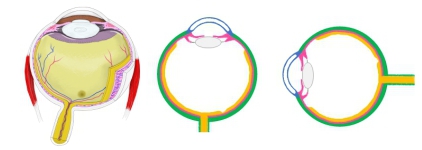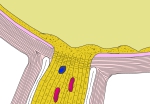







「 日本人体解剖学 」では以下の3つを網膜の特異な部位としている。
1. 視神経円板 : 眼球を内腔から見たときに視神経が進入する楕円形の部位
2. 黄斑 : 視神経円板の外側に位置する視覚が最も鋭敏な部分
3. 鋸状縁 : 網膜視部と網膜盲部の境界となる非常に薄い部分
|
|
|
|
眼球・視神経進入部 |
右眼球(横断面) |
左眼球・眼底 |
視神経円板・黄斑 |

以下が網膜を構成する細胞の一覧となる。 参考:「ChatGPT」
|
細胞の種類 |
役 割 |
1 |
視細胞 |
光を感知し、電気信号に変換(桿体細胞・錐体細胞) |
2 |
双極細胞 |
視細胞と次の神経細胞(主に神経節細胞)をつなぐ |
3 |
水平細胞 |
視細胞間の信号を横方向に調整し、コントラストや鋭敏さを調整 |
4 |
アマクリン細胞 |
双極細胞と神経節細胞の間で情報を調整・修飾 |
5 |
神経節細胞 |
最終的な視覚情報を脳へ伝える(軸索は視神経になる) |
6 |
ミュラーグリア細胞 |
網膜の構造支持・代謝サポート |

|
|
|
|
眼球・横断面 |
眼球・横断面 |
眼球模式図 |
眼球・縦断面? |
|

|

|
|
網膜視部・暗部 |
網膜視部の構造 |
眼球・視神経進入部 |
|

あ行 |
え |
|
お |
|
か行 |
き |
|
さ行 |
し |
|
た行 |
ち |
|
な行 |
に |
|
ま行 |
み |
|
も |
|

以下は「Wikipedia」の解説文となる。
The retina (from Latin: rete "net") is the innermost, light-sensitive layer of tissue of the eye of most vertebrates and some molluscs. The optics of the eye create a focused two-dimensional image of the visual world on the retina, which then processes that image within the retina and sends nerve impulses along the optic nerve to the visual cortex to create visual perception. The retina serves a function which is in many ways analogous to that of the film or image sensor in a camera.
【 語 句 】
・vertebrate:脊椎動物 ・mollusc:軟体動物 ・optic:(光学機械の)レンズ?.(weblio) ・two-dimensional:二次元の ・nerve impulse:神経インパルス(衝撃) ・optic nerve:視神経 ・visual cortex:視覚野 ・visual perception:視覚認知 ・analogous to ~:~に類似して
The neural retina consists of several layers of neurons interconnected by synapses and is supported by an outer layer of pigmented epithelial cells. The primary light-sensing cells in the retina are the photoreceptor cells, which are of two types: rods and cones. Rods function mainly in dim light and provide monochromatic vision. Cones function in well-lit conditions and are responsible for the perception of colour through the use of a range of opsins, as well as high-acuity vision used for tasks such as reading. A third type of light-sensing cell, the photosensitive ganglion cell, is important for entrainment of circadian rhythms and reflexive responses such as the pupillary light reflex.
【 語 句 】
・neuron: ・pigmented epithelial cell: ・photoreceptor cell: ・rod: ・cone: ・dim: ・,monochromatic: ・well lit:明るい ・opsin(レチネンと結合し色素ロドプシンを合成するタンパク質): ・acuity:鋭敏さ ・photosensitive ganglion cell:光感受性神経節細胞? ・entrainment: ・circadian rhythm: ・pupillary light reflex:
Light striking the retina initiates a cascade of chemical and electrical events that ultimately trigger nerve impulses that are sent to various visual centres of the brain through the fibres of the optic nerve. Neural signals from the rods and cones undergo processing by other neurons, whose output takes the form of action potentials in retinal ganglion cells whose axons form the optic nerve. Several important features of visual perception can be traced to the retinal encoding and processing of light.
【 語 句 】
・initiate:起こす ・cascade:階段状に連続する滝? ・event:事象? ・ultimately:最後に ・undergo:受ける ・processing:処理 ・action potential:活動電位 ・axon:軸索 ・visual perception:知覚認知 ・encoding:符号化?
In vertebrate embryonic development, the retina and the optic nerve originate as outgrowths of the developing brain, specifically the embryonic diencephalon; thus, the retina is considered part of the central nervous system (CNS) and is actually brain tissue. It is the only part of the CNS that can be visualized noninvasively. Much like the rest of the brain is isolated from the vasular system via the blood–brain barrier, the retina is similarly protected by the blood–retinal barrier.
【 語 句 】
・embryonic development:胚発生 ・outgrowth:派生物 ・diencephalon:間脳 ・noninvasively:非侵襲的に ・blood–brain barrier:血液脳関門 ・blood–retinal barrier:血液網膜関門?
【Structure】
□Inverted versus non-inverted retina□
The vertebrate retina is inverted in the sense that the light-sensing cells are in the back of the retina, so that light has to pass through layers of neurons and capillaries before it reaches the photosensitive sections of the rods and cones. The ganglion cells, whose axons form the optic nerve, are at the front of the retina; therefore, the optic nerve must cross through the retina en route to the brain. No photoreceptors are in this region, giving rise to the blind spot. In contrast, in the cephalopod retina, the photoreceptors are in front, with processing neurons and capillaries behind them. Because of this, cephalopods do not have a blind spot.
【 語 句 】
・inverted:逆になった? ・capillary:毛細血管 ・photosensitive:感光性の ・en route to~:~への途中 ・blind spot:盲点 ・cephalapod:(タコ・イカなどの)頭足綱の動物
Although the overlying neural tissue is partly transparent, and the accompanying glial cells have been shown to act as fibre-optic channels to transport photons directly to the photoreceptors, light scattering does occur. Some vertebrates, including humans, have an area of the central retina adapted for high-acuity vision. This area, termed the fovea centralis, is avascular (does not have blood vessels), and has minimal neural tissue in front of the photoreceptors, thereby minimizing light scattering.
【 語 句 】
・transparent: ・glial cell: ・fibre-optic:光ファイバーの ・photon: ・light scattering:光散乱 ・acuity:鋭敏さ ・fovea centralis:中心窩 ・avascular:無血管の
The cephalopods have a non-inverted retina, which is comparable in resolving power to the eyes of many vertebrates. Squid eyes do not have an analog of the vertebrate retinal pigment epithelium (RPE). Although their photoreceptors contain a protein, retinochrome, that recycles retinal and replicates one of the functions of the vertebrate RPE, cephalopod photoreceptors are likely not maintained as well as in vertebrates, and that as a result, the useful lifetime of photoreceptors in invertebrates is much shorter than in vertebrates. Having easily replaced stalk eyes (some lobsters) or retinae (some spiders, such as Deinopis) rarely occurs.
The cephalopod retina does not originate as an outgrowth of the brain, as the vertebrate one does. This difference suggests that vertebrate and cephalopod eyes are not homologous, but have evolved separately.
【 語 句 】
・resolving power:解像力 ・analog:相似器官 ・retinal pigmental epithelium:網膜色素上皮 ・retinochrome:レチノクロム(感光性色素蛋白)) ・replicate:模写する ・stalk:細長い支え ・homologous:相同の ・evolve:進化する
From an evolutionary perspective, a more complex structure such as the inverted retina can generally come about as a consequence of two alternate processes - an advantageous "good" compromise between competing functional limitations, or as a historical maladaptive relic of the convoluted path of organ evolution and transformation. Vision is an important adaptation in higher vertebrates.
A third view of the "inverted" vertebrate eye is that it combines two benefits - the maintenance of the photoreceptors mentioned above, and the reduction in light intensity necessary to avoid blinding the photoreceptors, which are based on the extremely sensitive eyes of the ancestors of modern hagfish (fish that live in very deep, dark water).
【 語 句 】
・perspective:考え方 ・come about:起こる ・consequence:結果、結論 ・alternate:交互の ・compromise:妥協 ・maladaptive:不適応の ・convoluted:回旋状の、入り組んだ ・adaptation:適応 ・hagfish:メクラウナギ
■ 写真やイラストを掲載しているサイト ■
・ イラストや写真を掲載しているサイト-Ⅰ
・ イラストや写真を掲載しているサイト-Ⅱ
・ イラストや写真を掲載しているサイト-Ⅲ
・ イラストや写真を掲載しているサイト-Ⅳ
・ イラストや写真を掲載しているサイト-Ⅴ
